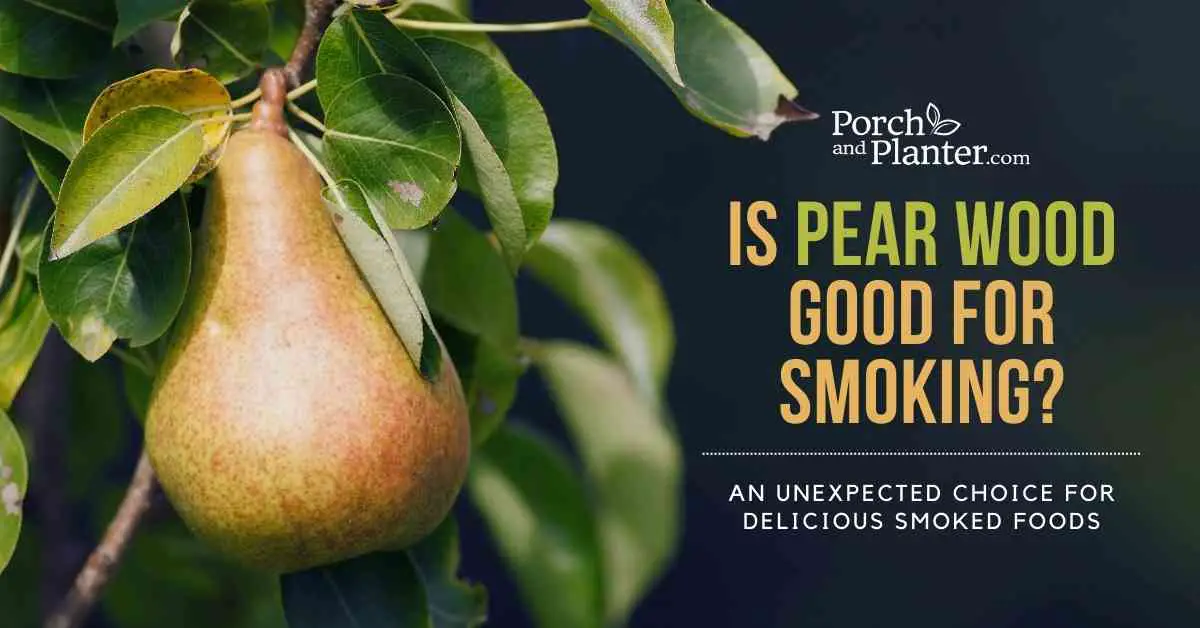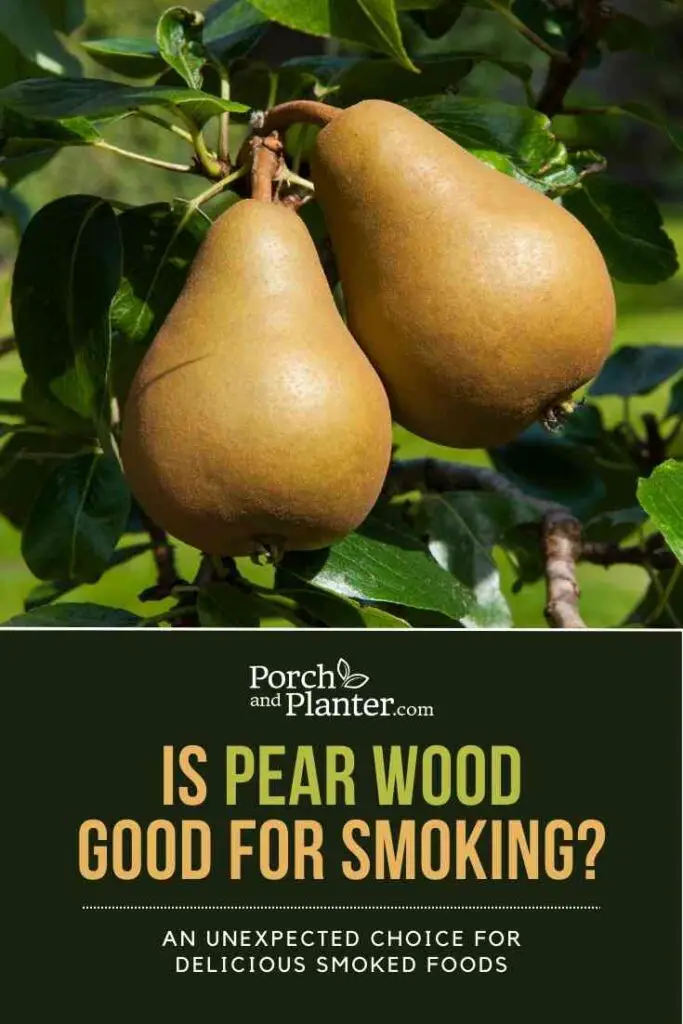Is Pear Wood Good for Smoking? The Unexpected Choice for Delicious Smoked Foods

Pear wood is a great choice for smoking a variety of foods, as its unique flavor doesn’t overpower the flavor of the food. Pear wood is a popular choice for smoking meats, fish, and vegetables. It is a hardwood that burns slowly and produces a sweet, delicate flavor. Unlike softwoods, which contain resins and compounds that can be harmful when burned, pear wood is a safe and effective choice for smoking.
When it comes to smoking, the type of wood used can have a big impact on the flavor of the finished product. Pear wood is known for imparting a mild, fruity flavor to meat, making it a popular choice among barbecue enthusiasts. It is often used in combination with other woods, such as hickory wood or apple wood, to create a unique flavor profile.
What is Pear Wood?
Pear wood is a type of hardwood that comes from the pear tree. The pear tree is a deciduous fruit tree that is native to Europe and Asia. The tree produces fruit, which is commonly eaten fresh or used in cooking and baking. The wood from the pear tree is often used for woodworking projects, such as furniture, flooring, and cabinetry.
There are different types of pear trees, and the wood from each tree can have different characteristics. One type of pear tree that is commonly used for smoking is the Bradford pear tree. The Bradford pear is a type of ornamental pear tree that is often planted in landscaping. The wood from Bradford pears is known for being dense and heavy, which makes it ideal for smoking meat.
When it comes to smoking meat, it is important to use a hardwood that has a low moisture content. Softwoods, such as pine and cedar, are not recommended for smoking because they contain high levels of resin, which can create a bitter taste in the meat. Hardwoods, on the other hand, have a lower moisture content and are better suited for smoking. Pear wood, including Bradford pear wood, is a hardwood that has a low moisture content, making it a good choice for smoking meat.
Is Pear Wood Good for Smoking?
If you’re cooking smoked meats, the choice of wood is crucial to achieving the desired smoke flavor. Pear wood is a popular option for smoking, but is it good for smoking? Let’s take a closer look.
Flavor Profile
Pear wood is known for its mild and fruity flavor, which makes it a versatile option for smoking various types of meat, poultry, fish, and vegetables. It is not as strong as some other woods like hickory or mesquite, but it still imparts a delicious flavor to the food.
Mild and Fruity Flavor
The mild and fruity flavor of pear wood is perfect for smoking meats like bacon, salmon, and game meats like venison. It also pairs well with beef and cheese, adding a unique and delicious flavor to these foods. The subtle fruity flavor also works well when grilling poultry.
Unique and Delicious
Pear wood is a unique and delicious option for smoking meat, especially pork. It is not as commonly used as other woods like oak or apple, but it can add a distinct flavor to the food that is sure to impress.
Heat and Moisture Content
Pear wood has a moderate heat and moisture content, which makes it a good option for smoking. It burns slowly and produces a generous amount of wood smoke, which is essential for smoking meat.
Preparing Pear Wood for Smoking
Before using pear wood for smoking, it is important to prepare it properly. This section will cover the necessary steps to ensure that the wood is ready to use.
Drying and Seasoning
One of the first steps in preparing pear wood for smoking is to dry and season it. Freshly cut wood contains a high amount of moisture, which can cause it to produce excess smoke and not burn evenly. To avoid this issue, the wood should be left to dry for several months. This will allow the moisture to evaporate and the wood to become more stable.
Seasoning the wood is also important. This involves exposing the wood to air and allowing it to reach a moisture content of around 20%. This process can take several months to a year, depending on the climate and conditions.
Splitting
Splitting the wood is another important step in preparing pear wood for smoking. This helps to expose the inner layers of the wood and allows for better air circulation during the smoking process. It also helps to create smaller pieces of wood that are easier to handle and use in the smoker.
Soaking
Soaking the wood is another option that can be used to prepare pear wood for smoking. This involves submerging the wood in water for several hours before use. Soaking can help to prevent the wood from burning too quickly and producing excess smoke. It can also help to add moisture to the wood, which can help to create a more flavorful smoke.
It is important to note that soaking the wood can also cause it to produce less smoke and flavor. This is because the water can dilute the natural flavors and oils in the wood. If using soaked wood, it is recommended to use smaller pieces and to monitor the smoking process closely to ensure that the wood is not burning too quickly or producing too much smoke.
Overall, preparing pear wood for smoking involves several important steps, including drying, seasoning, splitting, and soaking. These steps can help to ensure that the wood is ready to use and will produce a flavorful smoke. By following these steps, smokers can enjoy the unique flavor and aroma that pear wood can provide.
Using Pear Wood for Smoking
Grilling and Smoking Meat
Pear wood is a great choice for grilling and smoking meat, including poultry, beef, game, venison, and pork ribs. It imparts a delicate, fruity flavor to the meat, which is not too overwhelming. Pear wood burns slowly and evenly, producing a consistent smoke that permeates the meat, resulting in a deliciously smoked flavor.
When using pear wood for smoking meat, it is important to soak the wood chips or chunks in water for at least 30 minutes before smoking. This will help prevent the wood from burning too quickly and producing too much smoke, which can result in a bitter flavor.
Smoking Fish and Seafood
Pear wood is also an excellent choice for smoking fish and seafood, including salmon. The delicate flavor of the wood complements the natural flavors of the fish, resulting in a deliciously smoked flavor. Pear wood can be used alone or in combination with other woods, such as apple or cherry, to create a unique flavor profile.
When smoking fish and seafood with pear wood, it is important to use a low heat and to monitor the temperature closely. Fish and seafood are delicate and can easily become overcooked or dry if not smoked properly.
Smoking Vegetables and Cheeses
Pear wood can also be used to smoke vegetables and cheeses. It imparts a delicate, fruity flavor to the vegetables and cheeses, which is not too overpowering. Pear wood can be used alone or in combination with other woods, such as hickory or mesquite, to create a unique flavor profile.
When smoking vegetables and cheeses with pear wood, it is important to use a low heat and to monitor the temperature closely. Vegetables and cheeses can easily become overcooked or dry if not smoked properly.
Conclusion
Using pear wood for smoking can be a great choice for adding a unique flavor to your food. While it may not be as commonly used as other types of wood, such as hickory or mesquite, pear wood can provide a subtle sweetness and aroma that pairs well with a variety of meats and vegetables. However, it’s important to note that the quality of the wood can vary depending on factors such as age and moisture content, so it’s important to select high-quality pear wood for the best results. Overall, if you’re looking to experiment with new flavors in your smoking, pear wood can be a great option to try.







![Are Pavers Safe for a Fire Pit? [ANSWERED]](https://porchandplanter.com/wp-content/uploads/2021/09/Are-Pavers-Safe-for-a-Fire-Pit-768x402.jpg)